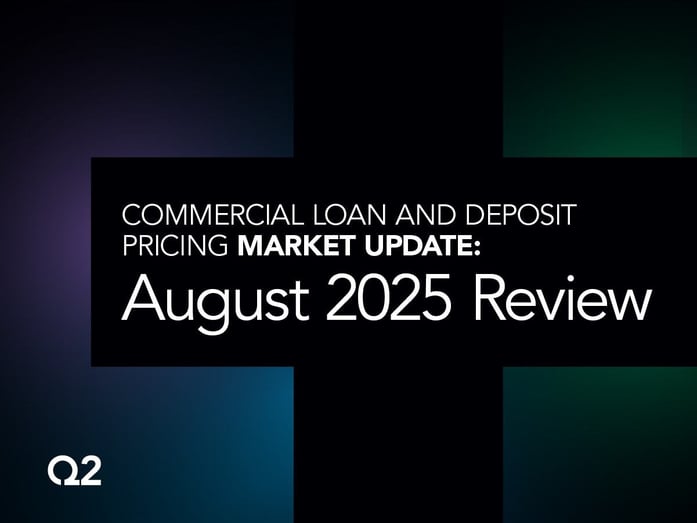Commercial Loan and Deposit Pricing Market Update: August 2025
26 Aug, 2025

Our August analysis of the Q2 PrecisionLender commercial loan and deposit pricing database took a look at the underlying factors that could make it easier for bankers and pricing managers to maintain and perhaps improve performance in the second half of 2025.
We also continued our yearlong comparison of new fixed-rate loans versus the Covid-era loans rolling off the books in 2025.
Read on for more details.
Data Notes:
- When we discuss the cost of funds (COF) on loan pricing activity, we refer to the marginal duration matched funding cost employed in pricing, not the bank’s actual average (historical) cost of funds
- We define Regional+ as institutions with more than $8 billion in assets, while Community are less than $8 billion
Volume levels remain high
Before diving into the volume numbers, we wanted to note that we have shifted the starting point forward on this chart from July 2025 to January 2025. We are making this switch because we now have seven months’ worth of data points for 2025 and to normalize for new Q2 PrecisionLender clients who have joined the database in recent months.
Previously, January 2025 volume had been at 111 when indexed to July 2024 at 100. Now January 2025 becomes that new index against which other months are compared. We have included both charts below so you can better understand the shift.
Using the new starting point, July 2025 volume dipped from June heights but remains the second highest volume month of the year. Using the new January 2025 index, the average volume for the past four months (112) has been above the Q1 2025 average (102).
Priced Commercial Loan Volume
$ Indexed to January 2025 = 100

Indexed Volume Transition From July 2024 to January 2025

Yield curve inversion eases
The inversion of the yield curve eased significantly in the 1- to 60-month range, by about 11 bps (from -0.51% to -0.40%). Rates in the 12- to 84-month range experienced an uptick of about 15 bps.
FHLB Curve
Selected Dates

Despite the month-over-month increase, it’s still worth noting that borrowing costs at the 60-month term—a proxy for fixed-funding costs—are down about 40 bps since the end of 2024. This reduction should offer bankers and pricing managers an easier landscape to either maintain or improve pricing performance in the second half of the year, compared to conditions in early 2025.
60-Month FHLB 2025 Trend

Liquidity costs ease slightly
Both fixed- and floating-rate liquidity costs were down slightly in July, with floating liquidity down 6 bps (from 0.65% to 0.59%) and fixed liquidity down 4 bps (from 0.34% to 0.30%). This is the third straight month that fixed liquidity costs have fallen after increasing steadily from January to April.
Approximate Liquidity Cost
Rolling Trend

Fixed-rate COF rise
Funding costs for fixed-rate structures reflect the increase in market rates, with an 11 bps rise in July. Floating-rate COF maintained the same flat line trajectory it has held throughout Q2 2025.
All-In COF by Month
Rolling Trend
Spreads remain stable
July gave us little of note to report for spreads. SOFR-based spreads experienced a modest increase of 3 bps while Prime-based spreads saw a slight decrease of 2 bps to 6 bps .
Weighted Average Spread to SOFR
The fixed-rate coupon over COF remained unchanged, as the rise in funding costs was matched by an increase in the coupon. (More on that below.)
Fixed-Rate Coupon Over COF
Fixed and SOFR coupons climb
Fixed-rate coupons increased 11 bps month over month, directly tracking a rise in COF. Meanwhile, SOFR coupons rose by approximately 6 bps, reflecting a combination of spread improvements and diverse SOFR indices used by clients.
Coupon Rate by Month
Rolling Trend
SOFR NIM continues to rise
While fixed-rate NIM remained unchanged month over month, SOFR-based NIM experienced an uplift of about 6 bps, driven equally by spread gains and index movements. It is the third straight month-over-month increase for SOFR-base NIM, which is up 13 bps from April (1.79% to 1.92%).
NIM by Month
Rolling Trend
Repricing Watch: Implied rate shock drops
As part of our continued examination of how bankers are handing the repricing of fixed-rate loans from the COVID era, we noted a significant shift in the implied rate shock for these loans. Initial estimates, forecasted at the start of 2025, anticipated an increase of about 1.67% for Q3 2025. But current recalibrations reflect reduced funding costs, which has moderated this implied rate shock to about 1.05%. That could ease repricing conditions for loans set to mature later this year.
Implied Rate Shock
However, it’s also worth noting that, despite favorable borrowing conditions, July's repricing showed mixed results. The new/repriced rate picked up 99 bps over the roll-off rate, but the NIM showed a larger gap (28 bps) than Q2 2025, which was 14 bps. Factors contributing to this result may include elevated origination costs and subdued fee collection. We will continue to monitor this in upcoming analyses.
NIM and Rates, Roll-Off vs. New

Deposit funding costs hold firm
Deposit funding costs continue to show little variation month over month. But it’s still worth a reminder that interest-bearing non-time deposits—a key market-responsive category—have dropped around 50 bps since the Federal Reserve initiated rate cuts in September 2024. This indicates a continued resistance to bank-led reductions in deposit pricing and an indication that overall deposit liquidity remains a preferred source of funding.
Interest-Bearing Non-Time (MMDA, CWI, Savings)
Rate Paid
Got questions?
Our banking consultants and data scientists are combing through Q2 PrecisionLender pricing data every day. If there is anything you’d like to know about what they’re seeing, please send your questions to insights@q2.com.